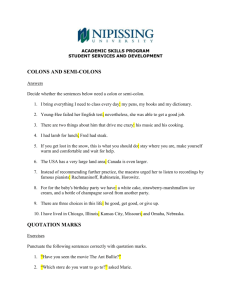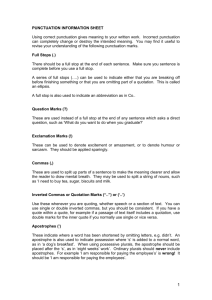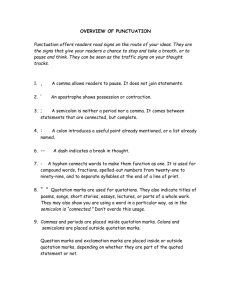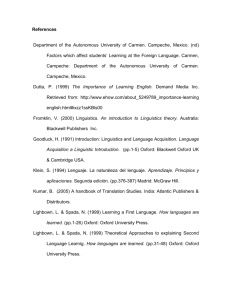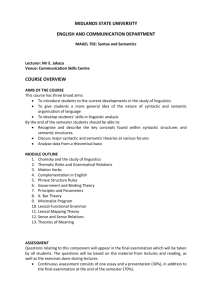Professor Norrick`s Style Sheet (adapted from
advertisement
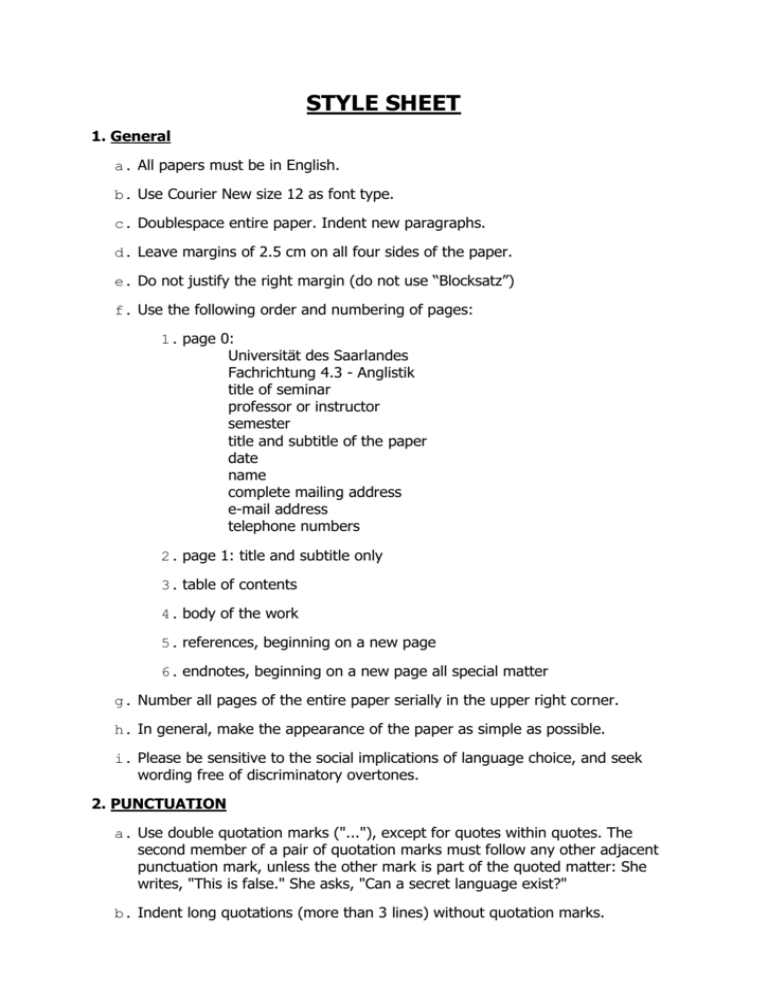
STYLE SHEET 1. General a. All papers must be in English. b. Use Courier New size 12 as font type. c. Doublespace entire paper. Indent new paragraphs. d. Leave margins of 2.5 cm on all four sides of the paper. e. Do not justify the right margin (do not use “Blocksatz”) f. Use the following order and numbering of pages: 1. page 0: Universität des Saarlandes Fachrichtung 4.3 - Anglistik title of seminar professor or instructor semester title and subtitle of the paper date name complete mailing address e-mail address telephone numbers 2. page 1: title and subtitle only 3. table of contents 4. body of the work 5. references, beginning on a new page 6. endnotes, beginning on a new page all special matter g. Number all pages of the entire paper serially in the upper right corner. h. In general, make the appearance of the paper as simple as possible. i. Please be sensitive to the social implications of language choice, and seek wording free of discriminatory overtones. 2. PUNCTUATION a. Use double quotation marks ("..."), except for quotes within quotes. The second member of a pair of quotation marks must follow any other adjacent punctuation mark, unless the other mark is part of the quoted matter: She writes, "This is false." She asks, "Can a secret language exist?" b. Indent long quotations (more than 3 lines) without quotation marks. c. Indicate ellipsis by three periods, close set, with a blank space before and after, like . . . this. 3. NOTES a. Keep notes to a minimum. b. Type all notes as endnotes, double spaced, following the entire text. c. Number all notes serially throughout the paper. d. The note reference number in the body of the text is a raised numeral (e.g. 1), not enclosed in parentheses. Place note numbers at the ends of sentences wherever possible, after all punctuation marks. e. Make each note a separate paragraph beginning with its reference number, raised above the line and not followed by any punctuation mark. 4. CITED FORMS a. Use italics for all cited linguistic forms and examples in the text. Do not use italics for emphasis, or to mark common loanwords or technical terms: ad hoc, façon de parler, ursprachlich, binyan, etc. b. Enclose transcriptions either within (phonetic) square brackets or within (phonemic) slashes: the suffix [s], the word /rek/. Do not italicize or underscore bracketed transcriptions. c. Use angle brackets for specific reference to graphemes: the letter < q >. d. Use single quotation marks for glosses of foreign words and meanings: Latin ovis 'sheep' is a noun. No comma precedes the gloss and no comma follows, unless necessary for other reasons: Latin ovis 'sheep', canis 'dog', and equus 'horse' are nouns. The word equus means 'horse', not 'cart'. e. Use a fine pen to insert special characters and diacritics by hand. Draw diacritics in the exact position and form that they are meant to assume in print. 5. TITLES AND HEADINGS a. Use Courier New not only for the body of the text but for all titles and headings as well. Do not use any special typefaces or type sizes. b. Capitalize only the first word and such words as the orthography of the language requires. c. Place section headings on a line with the section (note that the subdivisions of papers are called sections not chapters): 1 Introduction 2 The English sentence 2.1 The nominal group 2.1.1 Nominal premodification 2.1.2 Nominal postmodification 2.2 The verbal group 6. CITATIONS IN THE TEXT Within the text, give only a brief citation in parentheses consisting of the author's surname, the year of publication, and page number(s) where relevant: (Rice 1989) or (Yip 1991:75-6). a. If a cited publication has more than two authors, use the surname of the first author, followed by et al. b. If the author's name is part of the text, then use this form: Rice (1989:167) comments . . . c. Do not use notes for citations only. 7. REFERENCES At the end of the paper provide a full bibliography, double spaced, beginning on a separate page with the heading References. a. Arrange the entries alphabetically by surnames of authors, with each entry as a separate hanging indented paragraph. b. List multiple works by the same author in ascending chronological order. c. Use suffixed letters a, b, c, etc. to distinguish more than one item published by a single author in the same year. d. If more than one article is cited from one book, list the book as a separate entry under the editor's name, with crossreferences to the book in the entries for each article. e. Do not replace given names with initials unless the person normally uses initials: Barker, M. A. R., but Lehiste, Ilse. f. Use a middle name or initial only if the author normally does so: Heath, Shirley Brice; Oehrle, Richard T. g. Each entry should contain the following elements in the order and punctuation given: (first) author's surname, given name(s) or initial(s); given name and surname of other authors. year of publication. Full title and subtitle of the work. o For a journal article: Full name of the journal and volume number.inclusive page numbers for the entire article. o For an article in a book: title of the book, ed. by [full name(s) of editor(s)], inclusive page numbers. o For books and monographs, the edition, volume or part number (if applicable) and series title (if any). Place of publication: Publisher. h. italicize book titles and journal names i. place titles and quotations in quotation marks j. for internet sources see below k. Some examples follow Dorian, Nancy C. (ed.) 1989. Investigating obsolescence. Cambridge: Cambridge University Press. Fasold, Ralph. 1984. The sociolinguistics of society. Oxford: Blackwell. ----. 1990. Sociolinguistics of language. Oxford: Blackwell. Hale, Kenneth; and Josie White Eagle. 1980. A preliminary metrical account of Winnebago accent. International Journal of American Linguistics 46. 117-32. Hardy, Donald E. 1991. Free indirect discourse, irony, and empathy in Flannery O'Connor's "Revelation". Language and Literature 16. 37-53. Miner, Kenneth. 1990. Winnebago accent: The rest of the data. Lawrence: University of Kansas, ms. Perlmutter, David M. 1978. Impersonal passives and the unaccusative hypothesis. Berkeley Linguistics Society 4. 157-89. Poser, William. 1984. The phonetics and phonology of tone and intonation in Japanese. Cambridge, MA: MIT dissertation. Prince, Ellen. 1991. Relative clauses, resumptive pronouns, and kindsentences. Paper presented at the annual meeting of the Linguistic Society of America, Chicago. Rice, Keren. 1989. A grammar of slave. Berlin: Mouton de Gruyter. Sacks, Harvey. 1992. Lectures on conversation, volume 2. Oxford: Blackwell. ----; Emmanuel Schegloff; and Gail Jefferson. 1974. A simplest systematics for the organization of turn-taking in conversation. Language 50. 696735. Sinclair, John. 1966. Taking a poem to pieces. Essays on style and language, ed. by Roger Fowler, 68-81. London: Routledge. [also published in: Freeman, Donald C. (ed.) 1970. Linguistics and literary style, 129-142. Boston, MA: Holt.] Singler, John Victor. 1992. Review of Melanesian English and the Oceanic substrate, by Roger M. Keesing. Language 68. 176-82. Stockwell, Robert P. 1993. Obituary of Dwight L. Bolinger. Language 69. 99112. Tiersma, Peter M. 1993. Linguistic issues in the law. Language 69. 113-37. Yip, Moira. 1991. Coronals, consonant clusters, and the coda condition. The special status of coronals: internal and external evidence, ed. by Carole Paradis and Jean-Francois Prunet, 61-78. San Diego, CA: Academic Press. Yule, George. 1996a. The study of language, second edition. Cambridge: Cambridge University Press. ----. 1996b. Pragmatics. Oxford: Oxford University Press. Mailing Lists & Newsgroups Bilmes, Jack. 1999. Interaction and ethnography. Languse. [languse@sprog.auc.dk] Murphy, Lynne. 1999. Summary: Language games. LINGUIST List 10.819. [http://www.ling.ed.ac.uk/linguist/issues/10/10-819.html] World Wide Web Haenni, Ruedi. 1999. The case of Estuary English: supposed evidence and a perceptual approach. http://www.phon.ucl.ac.uk/home/estuary/haenni1999.pdf. If author name or publishing year not available proceed as follows: An electric language: An introduction to the socio-linguistics of the internet. http://www.oxy.edu/~scholl/writings/term.html. [no author, no publishing year] Nunberg, Geoff. The field of linguistics: An overview. http://www.lsadc.org/flxoverview.html. [no publishing year] E-zines Gajjala, Radhika. 1998. There are no last words online. Cybersociology 4. [http://www.socio.demon.co.uk/magazine/] Adapted from the Style Sheet of the Linguistic Society of America

